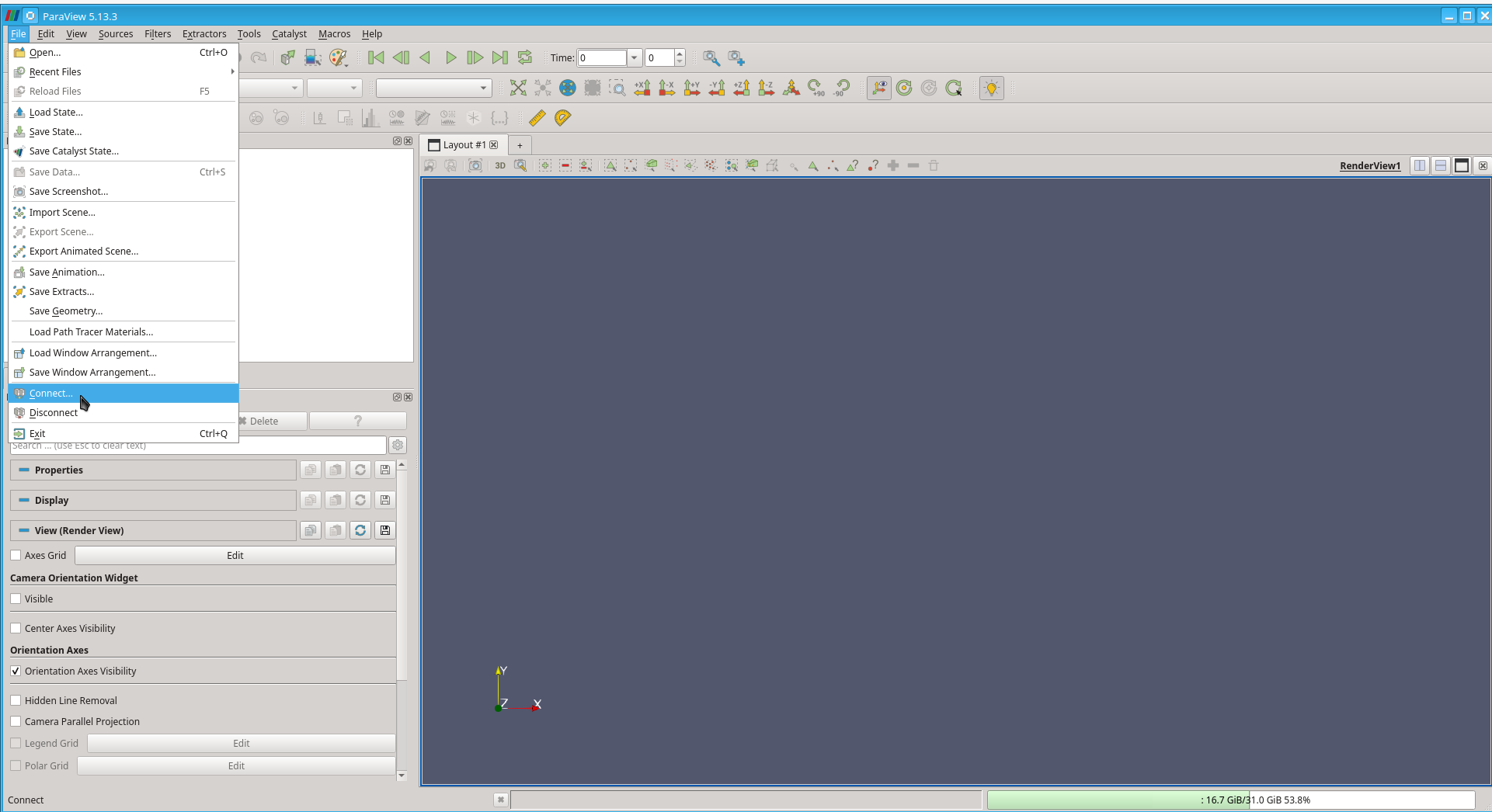ParaView
An interactive data analysis and visualisation tool with 3D rendering capability
Warning
We provide ParaView in two different flavours. Directly on the cluster we only support pvserver. (see manual below). A GUI version can be used with the HPC Desktop. The respective module has the suffix “-gui”.
Description
ParaView is an open-source, multi-platform data analysis and visualization application with interactive 3D or programmatical batch processing capabilities
Read more on ParaView home page. For a manual visit the ParaView Guide page.
Modules
| ParaView version | ParaView module file | Requirements | Island |
|---|---|---|---|
| 5.11.2 | paraview/5.11.2 | gcc/11.5.0 openmpi/4.1.7 | Emmy |
| 5.13.2 | paraview/5.13.2 | gcc/14.2.0 openmpi/4.1.7 | Emmy |
| 5.13.2 | paraview/5.13.2-gui | gcc/14.2.0 openmpi/4.1.7 | Emmy |
| 5.13.2 | paraview/5.13.2 | gcc/13.2.0 openmpi/5.0.7 | Grete |
| 5.13.2 | paraview/5.13.2-gui | gcc/13.2.0 openmpi/5.0.7 | Grete |
Example Use
The appropriate login nodes for this phase are glogin-p2.hpc.gwdg.de.
On the cluster: Start interactive job:
srun --partition=standard96 --nodes=1 --ntasks-per-node=96 --pty bashOn the cluster: Load prerequisite modules
module load gcc/14.2.0 module load openmpi/4.1.7 module load paraview/5.13.2On the cluster: Start ParaView-Server on your compute node gcn####
mpirun -n $SLURM_TASKS_PER_NODE pvserverWait a few seconds till your ParaView-Server provides a connection, typically with the port number 11111.
On your local computer: Start an ssh tunnel on your preferred terminal to access the port of the compute node via the respective login node of the NHR-NORD@Göttingen
ssh -N -L 11111:gcn####:11111 <user>@glogin-p2.hpc.gwdg.deIf this doesn’t work, you might need to try with a host jump option:
ssh -N -L 11111:localhost:11111 -J glogin-p2.hpc.gwdg.de -l <user> gcn####Leave this terminal window open to keep the tunnel running. Before setting up an ssh tunnel, check if your standard ssh login works. If you are a windows user without a proper terminal we recommend MobaXterm.
: Start your ParaView client GUI and access your ParaView-Server at
localhost:11111
The appropriate login nodes for this phase are glogin-p3.hpc.gwdg.de.
On the cluster: Start interactive job:
srun --partition=standard96s --nodes=1 --ntasks-per-node=96 --pty bashOn the cluster: Load prerequisite modules
module load gcc/14.2.0 module load openmpi/4.1.7 module load paraview/5.13.2On the cluster: Start ParaView-Server on your compute node c####
mpirun -n $SLURM_TASKS_PER_NODE pvserverWait a few seconds till your ParaView-Server provides a connection, typically with the port number 11111.
On your local computer: Start an ssh tunnel on your preferred terminal to access the port of the compute node via the respective login node of the NHR-NORD@Göttingen
ssh -N -L 11111:c####:11111 <user>@glogin-p3.hpc.gwdg.deIf this doesn’t work, you might need to try with a host jump option:
ssh -N -L 11111:localhost:11111 -J glogin-p3.hpc.gwdg.de -l <user> c####Leave this terminal window open to keep the tunnel running. Before setting up an ssh tunnel, check if your standard ssh login works. If you are a windows user without a proper terminal we recommend MobaXterm.
: Start your ParaView client GUI and access your ParaView-Server at
localhost:11111
The appropriate login nodes for this phase are glogin-gpu.hpc.gwdg.de.
On the cluster: Start interactive job:
srun --partition=grete --nodes=1 --ntasks-per-node=96 --pty bashOn the cluster: Load prerequisite modules
module load gcc/14.2.0 module load openmpi/4.1.7 module load paraview/5.13.2On the cluster: Start ParaView-Server on your compute node c####
mpirun -n $SLURM_TASKS_PER_NODE pvserverWait a few seconds till your ParaView-Server provides a connection, typically with the port number 11111.
On your local computer: Start an ssh tunnel on your preferred terminal to access the port of the compute node via the respective login node of the NHR-NORD@Göttingen
ssh -N -L 11111:c####:11111 <user>@glogin-gpu.hpc.gwdg.deIf this doesn’t work, you might need to try with a host jump option:
ssh -N -L 11111:localhost:11111 -J glogin-gpu.hpc.gwdg.de -l <user> c####Leave this terminal window open to keep the tunnel running. Before setting up an ssh tunnel, check if your standard ssh login works. If you are a windows user without a proper terminal we recommend MobaXterm.
: Start your ParaView client GUI and access your ParaView-Server at
localhost:11111
Please note: the version of your local ParaView client has to be the same as the remote ParaView-Server. You can download various ParaView versions here. You can run module list to see the version of the loaded paraview module.

